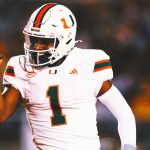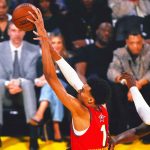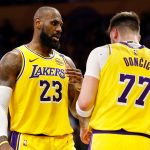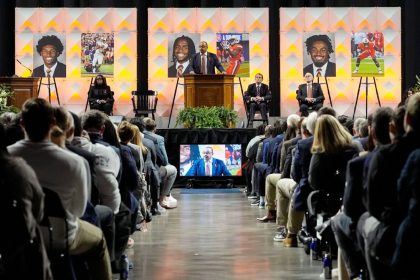HOUSTON — Let’s dispense with the theory that this Final Four marks a significant shift in men’s college basketball.
It is not.
But that doesn’t mean there won’t be a team or two like San Diego State and/or Florida Atlantic come along in the future.
A year ago, the Final Four had four blue bloods — Kansas, North Carolina, Duke and Villanova. It happened at the beginning of an era in which players could take advantage of Name Image and Likeness, the transfer portal, and an extra year of eligibility due to COVID-19.
This season, even with all three of those things seriously affecting the sport, the chances were still strong that a number of higher-profile teams could have made the Final Four.
- Kansas won the Big 12.
- Alabama, which had never been to the Final Four, was the No. 1 overall seed and had college basketball’s top NBA prospect in consensus freshman of the year Brandon Miller.
- Houston was in the Final Four in 2021 and had the same general makeup to do it again two years later.
- Purdue won the Big Ten regular-season and conference tournament titles.
- All four No. 1 seeds were trending in the right direction to make a run to NRG Stadium.
But …
- Kansas was without head coach Bill Self, who was recovering from a heart procedure.
- Alabama, like it or not, may have had too many off-court distractions, and dealing with San Diego State’s suffocating defense didn’t help.
- Houston wasn’t totally healthy and Miami was simply a better offensive team.
- Sorry, there is no explanation for Purdue losing to No. 16-seed Fairleigh Dickinson.
All that said, the lack of No. 2 and 3 seeds in this Final Four is more of an anomaly. Texas (2), Kansas State (3) and Gonzaga (3) all were in the Elite Eight and had a chance to advance but couldn’t get it done against Miami, Florida Atlantic and UConn, respectively.
ADVERTISEMENT
But let’s not rain on at least two of these teams as if they are some sort of whiff for the Final Four.
UConn? The Huskies are my definition of a blue blood and I don’t care who wants to argue.
The Huskies have won four national titles — three under Jim Calhoun and one under Kevin Ollie. The Huskies have produced countless NBA Draft picks and a number of All-Stars.
There was a bit of a March Madness drought from 2014 to 2023, but the Huskies still have more titles than UCLA and Indiana combined since 1999: UConn 4, Indiana/UCLA 0.
“Even when you’re down and you have UConn across your chest, you’re still everyone’s — it’s still a Super Bowl for the other coach and the other players because of the history and the tradition,” said UConn coach Dan Hurley.
The Huskies were rebuilt through the new combination of high school seniors, transfers and overall development.
UConn didn’t win the Big East — Marquette did in both the regular season and postseason tournament — but the Huskies were the most impressive Big East team in November, December and March. The mid-season slide was the only reason the Huskies were a 4-seed and not a No. 1, which is what they have played like in dominating Iona, Saint Mary’s, Arkansas and Gonzaga en route to Houston.
The Huskies are the favorites at the Final Four, the first time they have been in this position this season. But they aren’t embracing it.
“I still feel like we’re the underdog,” said UConn’s Andre Jackson Jr. “I feel like we’ve been that the entire year. I feel like we came into the season and a lot of teams, a lot of people, just underrated us. We still play with that same chip on our shoulder.”
Miami was in the Elite Eight last season. The ‘Canes shared the ACC regular-season title with Virginia. The narrative seems to be if it’s not North Carolina, Duke or Virginia then the ACC must be down. But Miami has proven that it is an elite ACC program under Jim Larrañaga.
The Hurricanes did benefit through the portal/NIL with the addition of Kansas State’s Nijel Pack. But he is just one piece of their returning puzzle. And to say that this team is only here due to the NIL deals would be completely wrong. Sure, it has helped, but there is much more to this story.
“NIL has been great,” said Pack. “We’ve really benefited from it. I think it’s great that basketball players get the benefit from their name, image and likeness. It’s been great for me. Honestly, the pressure is really not something I even pay attention to. Pressure just comes from other people putting it upon you. As long as you don’t put it upon yourself then it’s good. The only thing I worry about is to make sure we win games. We won a lot of games this year, so that kind of leaves people with nothing to say.”
Getting Pack in the portal, filling a void, was just as important as any added income.
“Basketball is my No. 1 thing,” said Pack. “Finding the right spot was something huge and with the transfer portal, I had to find a place that accept me. The opportunity that was there for me to be able to play the position that I wanted to and this is the perfect spot for me. They had a great roster already here and the opportunity presented itself. I found no other place better.”
The portal and NIL aren’t going anywhere. NIL as a recruiting inducement might settle down due to the donor class wanting to see more results before making payments. There may be a natural correction.
The COVID year, though, has made these teams older. Any player who was in college in 2020-21 could have an extra year — six years to play five instead of five to play four. That class will cycle out in 2024-25.
But it means teams like San Diego State, an accomplished power in the Mountain West Conference which just didn’t have March Madness success until this season, is older and ready for this run.
“It pretty much felt like this was all history in the making,” said San Diego State’s Keshad Johnson, referencing the 2020 Aztec team that was primed for a deep run had it not been for the pandemic. “COVID was a curse for a lot of my older teammates and the players, and we are back here for vengeance. We are living the dream and we are allowing them to live through us because they didn’t get to experience it. That’s why we are here.”
San Diego State coach Brian Dutcher, who helped rebuild the Aztecs with Steve Fisher decades ago, said, “We have a lot of older guys — fifth-year guys, sixth-year guys … We’ve got an older, older team.”
Meanwhile, all Florida Atlantic did was win 30-plus games. OK, so the Owls had never done this before and Conference USA is hardly a feeding ground for champions recently, but this Florida Atlantic team is still legit enough to get here. The Owls got the right mix of transfers, have developed their talent, and can play a variety of styles to win.
“We feel like teams who are called ‘Cinderellas’ don’t deserve to be here,” said FAU’s Alijah Martin. “They just have a good run in the tournament, but we’ve been good all year. Our record speaks for that, and like I said in my other interview, don’t call us Cinderella. You can call us ‘Beast Boys’ and you can call us ‘Pitbulls’ or ‘Rottweilers.’ You can call us a ‘really good basketball team.”
Added FAU coach Dusty May, “The term ‘Cinderella’ has always been that team that maybe hit a spurt late in the season and got hot where they average five made 3s a game, and then over the course of five games they make 12 a night. Whatever the case, it’s more of a flash in the pan versus a five-month body of work.”
So, all four of these teams are deserving and earned their spots.
But that doesn’t mean the top seeds won’t return to the top next season and beyond. Will we see this kind of Final Four again? Sure. Will it be every year? Nope.
“If you’re expecting all four No. 1 seeds to be at the Final Four every year, it doesn’t work that way,” said Larrañaga. “There’s too much parity in college basketball. There’s too many changes in rosters every year now. The transfer portal has created that. We’ve got transfers, every team has transfers.
“So even how your season starts is not really reflective of how you might be in February and March,” he said. “And it’s an impossible task for the committee to seed 1 through 68 and for everything to fall into place.”
Andy Katz is a longtime college basketball writer, analyst and host. He can be seen on the Big Ten Network, as well as March Madness and NCAA.com, and he hosts the podcast “March Madness 365.” Katz worked at ESPN for nearly two decades and, prior to that, in newspapers for nine years.
Read more:
CBK trending
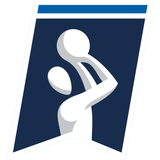
Get more from College Basketball Follow your favorites to get information about games, news and more

